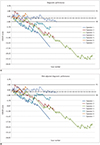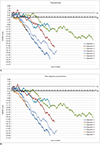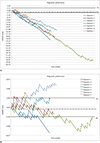Abstract
Objective
Materials and Methods
Results
Figures and Tables
 | Fig. 1CUSUM graphs of diagnostic performance.Standard (A) and risk-adjusted (B) CUSUM graphs of diagnostic performance. Upward movement indicates diagnostic failure, whereas downward movement indicates appropriate diagnosis. CUSUM = cumulative summation, H0 = lower decision limit, H1 = upper decision limit
|
 | Fig. 2CUSUM graphs of pneumothorax occurrence.Standard (A) and risk-adjusted (B) CUSUM graphs for pneumothorax occurrence.
|
 | Fig. 3Impact of failure rate on CUSUM graphs. Standard CUSUM graphs using different failure criteria.
A. When less strict failure rates were applied (p0 = 0.10, p1 = 0.20), all operators achieved proficiency after median of 33 procedures. B. When more harsh failure rates (p0 = 0.04, p1 = 0.08) were applied, only 2 reached lower decision limit and 2 operators crossed upper decision limit, suggesting poor performance, even after finishing their training.
|
Table 1
Construction of Cumulative Summation Charts with Varying Acceptable and Unacceptable Failure Rates

Table 2
Clinical and Lesion Characteristics among Operators

Unless otherwise indicated, data are numbers of patients, and data in parentheses are percentages. *Data are mean ± standard deviation, †Total of 2042 PTNB procedures in 1948 patients (M:F = 1147:801; mean age, 63 ± 12 years) were analyzed in this study. In patients who underwent PTNB procedures more than two times, each procedure was described as independent case with separate inclusion of sex and age. N/A = not applicable, PTNB = percutaneous transthoracic needle biopsy
Table 3
Diagnostic Success Rate and Pneumothorax Occurrence Rate in Seven Operators during Their Experiences

Notes
This study was supported by the Industrial Technology Innovation Program funded by the Ministry of Trade, Industry & Energy (MOTIE), Republic of Korea (grant number: 10080531) and the Korea Health Technology R&D Project through the Korea Health Industry Development Institute (KHIDI), funded by the Ministry of Health and Welfare, Republic of Korea (grant number: HC15C3390).




 PDF
PDF ePub
ePub Citation
Citation Print
Print




 XML Download
XML Download